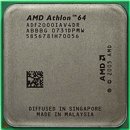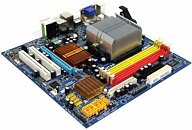Sunday, August 17th 2008

AMD Athlon 64 2000+ for Immediate Competition with Intel Atom
While AMD touted the Bobcat as a definitive competitor to Intel Atom, being a low-power K8 based part with the same design advantages its ancestors had over competing Intel parts when they made up for higher performing alternatives, this part won't make it until next year, enough time for the Atom to gain a stronger foothold in the market. As immediate competition to the Atom, AMD seems to have set an Athlon 64 2000+ single core processor as its ULPC / UMPC processor part. This processor is single core, features a 1.00 GHz clock-speed and 256 KB of L2 cache, which should still give it a performance edge over a 1.50 GHz Atom judging purely by the fact that the Atom isn't based on the Core micro-architecture (yet) and uses an older design.
This processor is based on the Lima core, what's most surprising is that it is found to operate at 8 W at its 1.00 GHz frequency which brings it into the Atom platform's energy domain. The second most surprising point is that this processor will be aided by the powerful AMD 780G core logic (chipset), as opposed to current Atom platforms using a i945G adaptation that has significantly higher thermal envelope as opposed the AMD 780G while being a lot slower (in terms of graphics performance and features). Tom's Hardware conducted a comparison between the two and found that the Athlon-780G combo "knocks-out" Atom-i945G technologically.
The AMD 780G uses a fraction of the power i945G uses and makes up for several features the i945G lacks. The only drawback as of now is that AMD hasn't quite been able to reduce the board footprint of these parts. Despite having double the TDP to that of Atom, at 8 W, the Athlon chip still remained comfortable with passive cooling. This opens up a new round of competition, of that between Athlon and VIA Nano which claims to have higher levels of performance / watt over Intel Atom. The first picture shows the processor itself, the second one shows the processor seated on a AMD 780G based motherboard made by Gigabyte, where the processor is made to be cooled by the stock AMD AM2 cooler with the fan removed, to study the effects of passive cooling on the processor.
Source:
Tom's Hardware
This processor is based on the Lima core, what's most surprising is that it is found to operate at 8 W at its 1.00 GHz frequency which brings it into the Atom platform's energy domain. The second most surprising point is that this processor will be aided by the powerful AMD 780G core logic (chipset), as opposed to current Atom platforms using a i945G adaptation that has significantly higher thermal envelope as opposed the AMD 780G while being a lot slower (in terms of graphics performance and features). Tom's Hardware conducted a comparison between the two and found that the Athlon-780G combo "knocks-out" Atom-i945G technologically.
The AMD 780G uses a fraction of the power i945G uses and makes up for several features the i945G lacks. The only drawback as of now is that AMD hasn't quite been able to reduce the board footprint of these parts. Despite having double the TDP to that of Atom, at 8 W, the Athlon chip still remained comfortable with passive cooling. This opens up a new round of competition, of that between Athlon and VIA Nano which claims to have higher levels of performance / watt over Intel Atom. The first picture shows the processor itself, the second one shows the processor seated on a AMD 780G based motherboard made by Gigabyte, where the processor is made to be cooled by the stock AMD AM2 cooler with the fan removed, to study the effects of passive cooling on the processor.


75 Comments on AMD Athlon 64 2000+ for Immediate Competition with Intel Atom
nice one amd, this is what amd should have done from day 1, where intel is weak amd should av been king. SIMPLE
AMD Lima is HUGE
...not good for embedded or pica-ITX.
Just applying Moore's law of doubling CPU power every 18 months, we should expect Lima to beat current Atom by at least 100% in order to be a clear winner in 9 months time.
... I'm not seeing it at all. It's going to be about the same performance as Atom is today. The only time Lima beats Atom is when HT is turned off. In fact, being so late to market and no better in performance and being so much bigger, there is only one descriptive: FAIL
The intel solution isnt blu ray capable (something one would want in a htpc), and with todays high energy rates one could se how one would want a low powered htpc or download box.
the amd solution has 3 times the sata ports, insanely faster onboards graphics, just to name a few.
The real downside is, as you said, the size of the chip, but I highly doubt that is going to restrict it in the netbook market. UMPCs, maybe, but do we even have full-speed Atom chips in the UMPC market to begin with? No, nor is that a market consumers are particularly interested in anyway. The primary issue as I see it will come from the higher cost of production for AMD, especially given that they will be competing in a low-margin market to begin with. As the Tom's preview pointed out, while I'm sure AMD's yields on K8 chips are doing just fine, what we're not sure of is how many of them can run at the voltage standard this chip is setting, and that may be what ultimately creates a good deal of trouble for the project until its successor arrives...
www.tomshardware.com/reviews/Atom-Athlon-Efficient,1997-8.html
It has to be the worst possible synthetic benchmark. (besides the old sysmark that intel owned, but would never admit to).
This 8W isn't jack with the mem controller on there and w/o a chipset devouring power unlike the atom.
They need to take off the heatspreader and spread out those fins along the MB (a nice new and thin cooler design).
I say this is a good move by AMD, get in everywhere. the netbook is the "it" thing these days so it may pay off for AMD.
The CPU is faster, but uses more power - the chipset is faster, more modern, and better features - yet it uses less power. Overall the AMD system is as clear winner.
Edit: Just messing around with AOD and droped the multi to 5x and the fsb to 100 and got it to .5ghz each core. Didn't apply though.